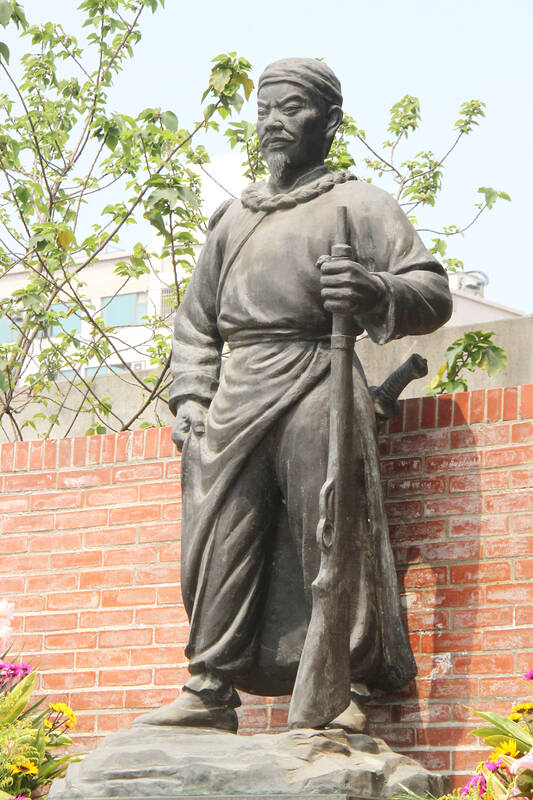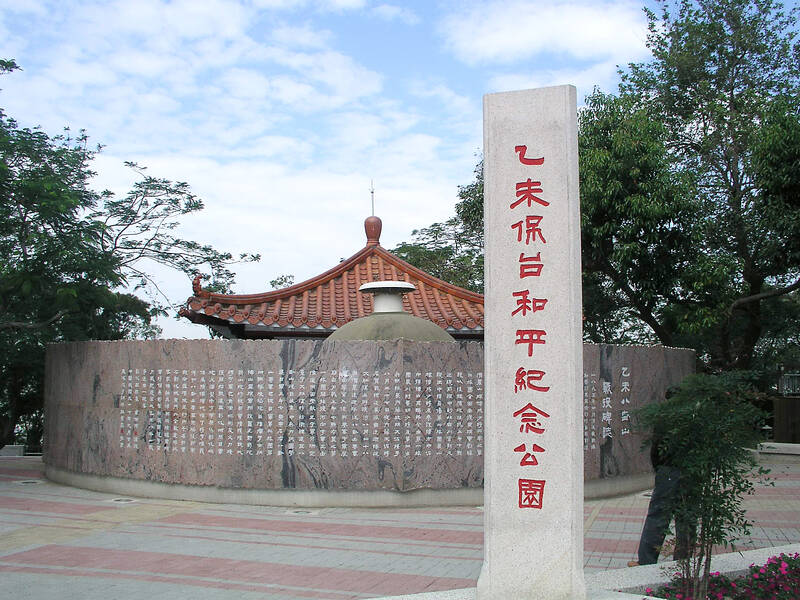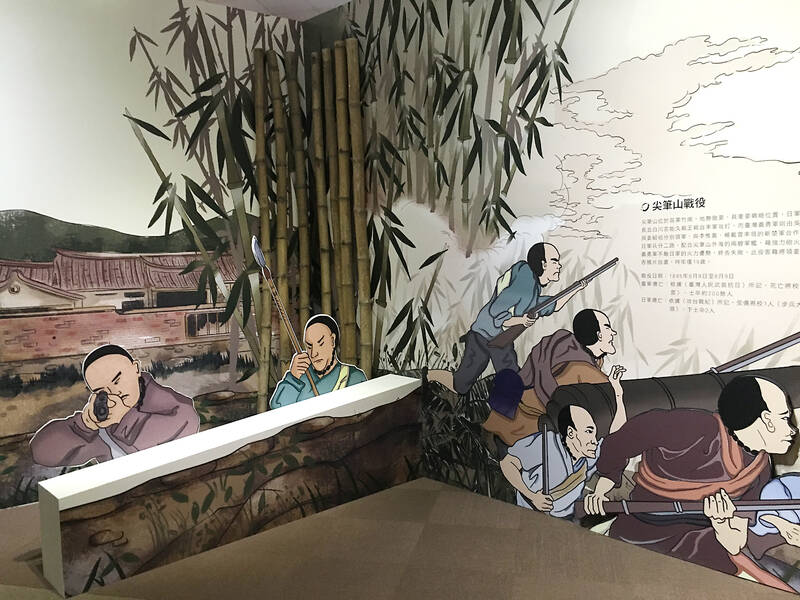JUNE 30 to JULY 6
After being routed by the Japanese in the bloody battle of Baguashan (八卦山), Hsu Hsiang (徐驤) and a handful of surviving Hakka fighters sped toward Tainan.
There, he would meet with Liu Yung-fu (劉永福), leader of the Black Flag Army who had assumed control of the resisting Republic of Formosa after its president and vice-president fled to China. Hsu, who had been fighting non-stop for over two months from Taoyuan to Changhua, was reportedly injured and exhausted.

Photo : Lin Hsin-han, Taipei Times
As the story goes, Liu advised that Hsu take shelter in China to recover and regroup, but Hsu steadfastly refused, vowing to live and die with his homeland. Instead, he headed to the Hakka area of Liudui, Pingtung to recruit fresh troops and rushed back to the frontlines.
The last two “Taiwan in Time” columns detailed the Hakka-led resistance against the Japanese colonizers in Taoyuan, Hsinchu and Miaoli. After landing in Taiwan on May 31, 1895 and capturing Taipei within a week, the Japanese expected to advance south quickly and capture Tainan to control the west coast.
However, the battle-hardy Hakka put up a valiant fight in conjunction with Republic of Formosa forces and other militias, stalling the Japanese advance for more than a month in Hsinchu. Hsu was present at almost every battle, even leading forces to disrupt Japanese communications between clashes.

Photo: Wu Wei-kung, Taipei Times
In the end, they were no match against superior Japanese firepower. Some say Hsu died in Douliu (斗六), Dounan (斗南) or Chiayi, and others maintain that he lasted until the final stand by the Zengwen River (曾文溪), just north of Tainan City.
CALl TO ARMS
Hsu was born around 1858 to a prominent family in Miaoli’s Toufen Township (頭份). While he trained in martial arts growing up, he pursued a scholarly career, passing the imperial examinations at age 18 and setting up a private academy in his hometown.

Photo: Chang Teng, Taipei Times
When he heard about the Japanese landing in Taiwan, Hsu immediately began raising an army to resist, eventually spending his entire fortune on the effort. He fought alongside fellow Hakka militia leaders Wu Tang-hsing (吳湯興) and Chiang Shao-tzu (姜紹祖), both of whom also passed the imperial examinations, and the trio has been dubbed in modern literature as the “Three Hakka Scholars,” “Three Hakka Heroes,” or “Three Hakka Musketeers.”
Two days after the fall of Taipei on June 7, 1895, Wu, who was appointed commander of the civilian militias by the Republic of Formosa, issued a call to arms in Hsinchu. Various militias gathered in the walled city over the next few days, including Hsu’s, vowing to reclaim Taipei and drive the colonizers out of Taiwan.
However, the Japanese invasion force was already on the move after setting up administrative offices in Taipei, so defending Hsinchu was first priority.

Photo courtesy of Green Film Production
Hsu first saw action sometime between June 12 and June 14, when the Hakka militias clashed with the Japanese vanguard north of today’s Hukou Township (湖口, the exact location is disputed), writes Hsueh Yun-feng (薛雲峰) in “The historical standpoint of the Taiwan Hakka: The case of the yimin and the war of 1895” (臺灣客家史觀: 以義民與1895乙未抗日戰爭為例).
The resistance emerged victorious after days of defending their base in Hukou, driving the Japanese back to Jhongli (中壢). However, the Japanese regrouped and sent reinforcements from Taipei, capturing Hsinchu on June 22 despite heavy losses.
JAPANESE ADVANCE
Despite failing multiple attempts to reclaim Hsinchu, the Hakka militias and civilian defenders managed to stall the Japanese advance in the area for over a month. Chiang was the first musketeer to fall, allegedly committing suicide after being captured during an assault on Hsinchu.
In mid-July, internal conflict arose between Miaoli governor Lee Chuan (李烇) and Wu Tang-hsing over war funds and leadership. Lee Chuan reportedly complained to Taiwan Prefecture governor Lee Ching-sung (黎景嵩) that Wu was unfit to be leader and his successes were all due to Hsu’s battle prowess, writes historian Lin Cheng-hui (林正慧) in “The Hakka during the Japanese invasion of Taiwan in 1895” (1895年乙未之役中的臺灣客家).
Despite the support of Lee Ching-sung’s New Chu Army and Liu Yung-fu’s Black Flag Army, the Japanese crushed the Hakka forces in the Battle of Jianbishan (尖筆山) on Aug. 8 in today’s Jhunan Township (竹南). They also captured Hsu’s hometown of Toufen on the same day.
From there, they steamrolled past Miaoli and Taichung despite fierce opposition by Hsu and other militias, and faced off with the resistance forces at Baguashan on Aug. 28, which is considered the largest battle of the war. Wu died in the fighting, while Hsu fled south with about 20 or 30 soldiers.
Hsu’s saga differs significantly by source after this, but the consensus is that he did meet with Liu in Tainan, recruited between 300 and 700 soldiers and headed back to the frontlines in Yunlin.
DISPUTED FINAL STAND
The Japanese continued to advance, but local militias led by Hsiao San-fa (蕭三發), Chien Ching-hua (簡精華) and others managed to drive them back to Changhua. Some sources have Hsu participating in this effort, while others state that he arrived afterward to defend Douliu.
However, with more reinforcements arriving from Japan, the Japanese launched a massive, multi-pronged attack by both land and sea toward Tainan. Hsu and company clashed with the enemy in Dounan and Douliu, losing both battles.
According to some accounts, Hsu’s story ends here, succumbing to enemy fire in Yunlin.
However, most accounts, including Hsu’s monument in Toufen, have him participating in the subsequent battle of Chiayi on Oct. 9. The Japanese forces continued to swell as support troops arrived by sea, and the resistance made its last stand on Oct. 20 (some sources say Oct. 13) by the Zengwen River. The most popular version of the story has Hsu, dying by cannon fire here.
Liu Yung-fu, who had been trying to sue for peace, fled to China around this time, and Tainan capitulated on Oct. 21 without any resistance. Governor-general Sukenori Kabayama declared Taiwan “pacified,” but the fight was not over yet.
Taiwan in Time, a column about Taiwan’s history that is published every Sunday, spotlights important or interesting events around the nation that either have anniversaries this week or are tied to current events.

This month the government ordered a one-year block of Xiaohongshu (小紅書) or Rednote, a Chinese social media platform with more than 3 million users in Taiwan. The government pointed to widespread fraud activity on the platform, along with cybersecurity failures. Officials said that they had reached out to the company and asked it to change. However, they received no response. The pro-China parties, the Chinese Nationalist Party (KMT) and Taiwan People’s Party (TPP), immediately swung into action, denouncing the ban as an attack on free speech. This “free speech” claim was then echoed by the People’s Republic of China (PRC),

Exceptions to the rule are sometimes revealing. For a brief few years, there was an emerging ideological split between the Democratic Progressive Party (DPP) and Chinese Nationalist Party (KMT) that appeared to be pushing the DPP in a direction that would be considered more liberal, and the KMT more conservative. In the previous column, “The KMT-DPP’s bureaucrat-led developmental state” (Dec. 11, page 12), we examined how Taiwan’s democratic system developed, and how both the two main parties largely accepted a similar consensus on how Taiwan should be run domestically and did not split along the left-right lines more familiar in

Many people in Taiwan first learned about universal basic income (UBI) — the idea that the government should provide regular, no-strings-attached payments to each citizen — in 2019. While seeking the Democratic nomination for the 2020 US presidential election, Andrew Yang, a politician of Taiwanese descent, said that, if elected, he’d institute a UBI of US$1,000 per month to “get the economic boot off of people’s throats, allowing them to lift their heads up, breathe, and get excited for the future.” His campaign petered out, but the concept of UBI hasn’t gone away. Throughout the industrialized world, there are fears that

The Democratic Progressive Party (DPP) controlled Executive Yuan (often called the Cabinet) finally fired back at the opposition-controlled Legislative Yuan in their ongoing struggle for control. The opposition Chinese Nationalist Party (KMT) and Taiwan People’s Party (TPP) acted surprised and outraged, but they should have seen it coming. Taiwan is now in a full-blown constitutional crisis. There are still peaceful ways out of this conflict, but with the KMT and TPP leadership in the hands of hardliners and the DPP having lost all patience, there is an alarming chance things could spiral out of control, threatening Taiwan’s democracy. This is no